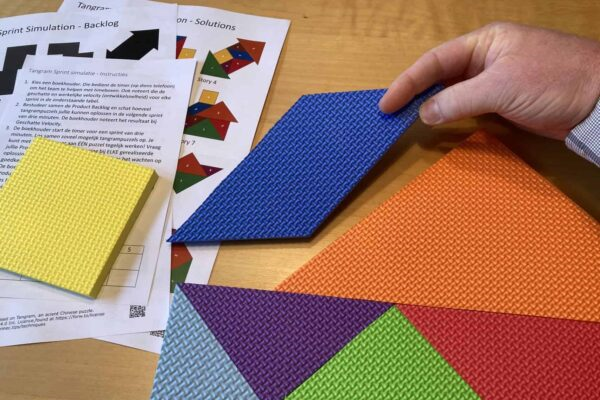Goal
In the Tangram Sprint Simulation, participants explore the effect of short cyclical collaboration while experimenting, learning, and improving. This lays the foundation for applying/improving the (Scrum) way of working in a team.
The classic Tangram game for 1 or more people ages 8 and up is not a game in the tightest sense of the word, it is a philosophy, an attitude of life. With only 7 puzzle pieces—one square, one parallelogram and 5 triangles—you can depict simple, contiguous, shapes and figures in thousands of combinations. The game provides an entrance into the world of mosaic. Your imagination and ideas will show you the way.
- Icrease in endurance
- Increase in patience
- More effective retrospectives
- Better communication and collaboration
Videos
Rabbit Tangram Puzzle (1 minute, EN)
Learn to puzzle a rabbit with TANGRAM
To Work

As a trainer/facilitator, play the role of Product Owner/Customer for the participants. In doing so, go through the following steps.
- Divide participants into teams of 2 to 3. Give each team one set of Tangram puzzle pieces, a pen, an instruction sheet with score table and improvement experiments, and a backlog of Tangram figures. If necessary, provide a cooking timer to keep track of time (can also be done with one participant’s cellphone).
- Make sure that ONLY you have this instruction for the trainer/facilitator and the sheet with the solutions at hand!
- Read aloud the description of Tangram – Origin and Rules on the back of the Facilitator Instructions to the participants.
- Have participants read through the Instruction for Participants with score table. Answer any questions and start the simulation.
- In the interim, keep a scoreboard with the estimated and realized velocities for each team. Only include the number of solutions verified by you in the realized velocity.
- After the simulation, collect insights and let the participants examine what these mean for their (daily) way of working (and application of Scrum).
During the game, pay attention to the following:
- Provide help and tips only when participants ask for them.
- Make sure that all puzzle pieces are used in each solution. If not, say you think the solution is too small (it must be at least 40 cm high).
- When accepting, apply tight additional requirements such as:
- Could you put the darkest large triangle at the bottom of all puzzles as much as possible? It looks more stable that way.
- Could you put the ribbed/colored side on the upside for all puzzle pieces?
- Could you put the puzzle pieces to lie tightly together, we need quality?
- I want all the corners to line up as neatly as possible, this is too messy.
- The solution should lie nice and straight, like in the picture.
- You may make up additional requirements as a Product Owner.
We hope you
enjoy and gain useful insights from this simulation.
Source
You find more on improving teamwork in our book Connective Teamwork. The book helps you set your team in motion with a practical 5-step plan and 20 teamwork techniques.
You can learn more about and practice this technique in our Connective Team Coach Training Course.

Contact me


